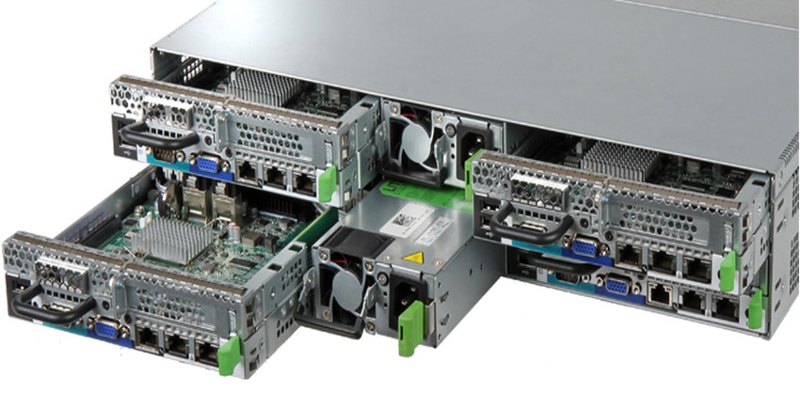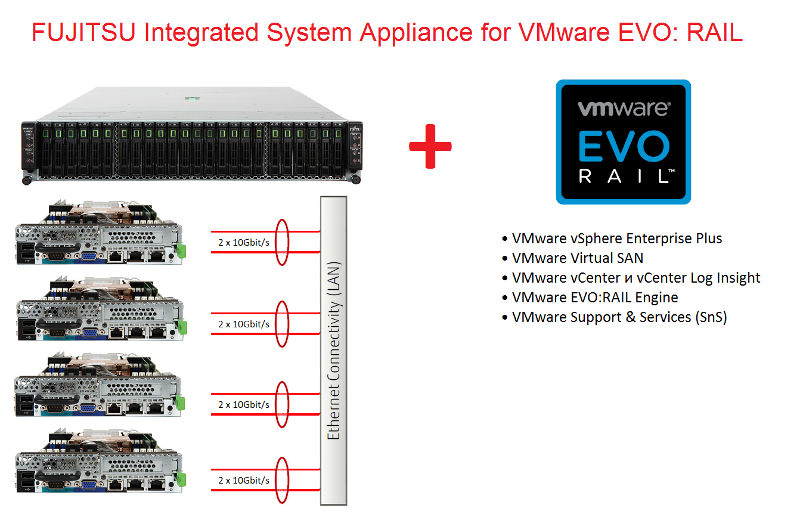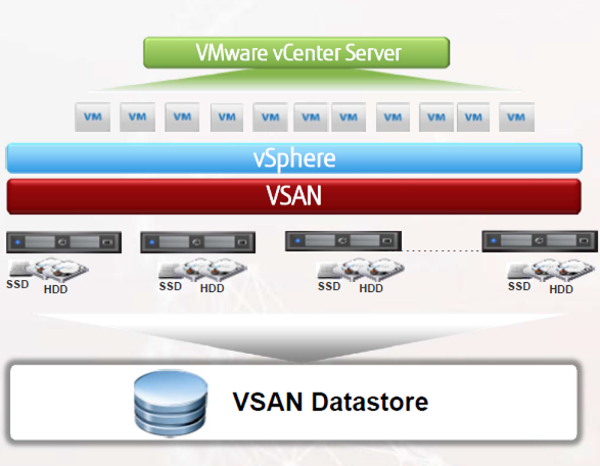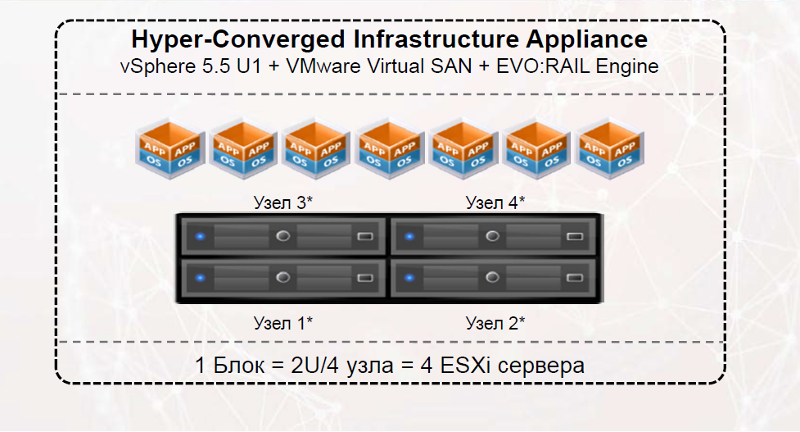Fujitsu Optimized Server Solution for VMware EVO: RAIL

Modern business in large numbers generates new and new tasks, and IT, in turn, should provide their solution, and with maximum speed and minimum costs. Business brings new services to the market, and the faster it does, the more likely it is to gain strong positions with the prospect of further growth. IT is obliged to provide and deploy the appropriate applications to ensure the operation of these services. This time we will talk about one of the newest IT solutions for small and medium businesses - the hyper-converged infrastructure of the Fujitsu Integrated System Appliance for VMware EVO: RAIL.
The best way to solve such problems is virtualization. Deploying an application on a virtual server is much faster and cheaper than on a physical one. Moreover, the price benefit applies to both installation and, most importantly, the subsequent operation. According to Gartner analysts, by 2016 71% of the infrastructures will be fully virtualized. At the same time, the complexity of networks increases. Many companies use both physical and virtual servers, and virtual servers, in turn, use several hypervisors from different manufacturers.
')
An integrated infrastructure can help to overcome these difficulties, where there are no boundaries between physical and virtual servers, storage systems and other components, since all this complex “economy” is managed from a single console. This greatly facilitates the work of management and administration. A vivid example of such an integrated solution can be called a smartphone or tablet, with which you can solve a wide range of tasks - calls, internet surfing, listening to music, watching videos, reading books, taking photos, working with office documents and much more. However, the management of such a device is carried out from a single menu and a single interface.
To manage virtual environments that are becoming more complex from year to year, we also need integrated tools. One of those can be called the Fujitsu Integrated System Appliance for VMware EVO: RAIL. This decision was announced at the end of the summer of this year, and officially presented to Russian users in early November. The system is built on an integrated principle. This means that configuring, managing, deploying, updating - all this is concentrated in a single console. Physically EVO: RAIL is a 2-unit Fujitsu Primergy CX400 server with four compute modules, each of which is equipped with two processors, RAM, spacious SSD and SAS drives, as well as a 10-Gbps Ethernet interface. The solution includes all necessary licenses for VMware products.

This is a basic solution, the foundation of the entire infrastructure. And it also contains everything you need. If we are talking about a small infrastructure, one such “brick” will be enough for the customer, if the infrastructure is growing and the solution needs to be scaled, you just need to purchase additional “boxes” and not think about which drives you need to buy, whether there are enough licenses and tons .d At the same time, the process of adding a new module does not cause any difficulties, since the system automatically recognizes new resources using IPv6 auto-discovery, connects to them and creates new virtual machines. In the first version of EVO: RAIL, 16 servers can be included in one cluster, which is quite a lot even for medium-sized companies.

As for the software component EVO: RAIL, it is built entirely on the products of VMware. It is based on three basic components. The first is vSphere 5.5 U1, a well-known and popular virtualization solution on the market. It allows you to virtualize almost any application and any tasks arising from the customer. For business vSphere is useful, first of all, because it allows to reduce capital and operating costs, while maintaining the quality of service at a high level.

The second component of the solution is VMware Virtual SAN. It allows you to build fault-tolerant storage on the basis of local hard drives and SSD-drives that can withstand both single and multiple failures. Virtual SAN allows you to abstract available storage resources from physical hardware, supports configuring and managing policy-based storage and infrastructure scaling with SSD caching. Along with classic storage systems, VSAN Datastore is supported - a new solution from VMware that allows you to record all input and output from virtual machines directly to SSD and then rewrite it to HDD. The creation of such a solution was made possible due to a significant reduction in the cost of SSD-drives.
The third component of the EVO: RAIL solution, which “sticks together” the rest, is called the EVO: RAIL Engine. This engine is written from scratch on HTML5, without the use of Flash and other languages. It simplifies the deployment of the system and the process of its administration. Almost any modern platform and any modern web browser will work for the engine.

The deployment of the EVO: RAIL is quite simple, and for its implementation does not need to attract highly qualified specialists. First of all, you need to fill in a simple menu of basic settings, which will then be checked for correctness in automatic mode. After that, in a matter of minutes, also automatically, the solution will be deployed. We are talking about the deployment of hypervisors and their control center, setting up a cluster of equipment (balancing, fault tolerance, etc.). Then virtual machines are created, which is also not associated with any difficulties. If necessary, you can connect using the web client and fine-tune the virtual machines.

How can an EVO: RAIL solution be useful? First of all, the fact that it allows working with a virtual infrastructure to those divisions and those employees who do not have special knowledge in the field of working with it. Secondly, it simplifies the process of managing and monitoring equipment as much as possible, since it displays the load, memory status, and other parameters for each server, unit, or entire cluster, and also warns of failures and errors. In addition, integration with VMware vCenter Log Insight - server for collecting logs has been implemented. The process of updating an EVO solution: RAIL is implemented with zero downtime. All downloaded updates from VMware have already been pre-tested for compatibility with the hardware.
As for the EVO: RAIL usage scenarios, here we can note the rapid commissioning of IT infrastructure. No need to check every component. If one node works, then all the rest will work. And all the work on the connection comes down to unpacking the box, installing it in a rack, plugging it into the socket and connecting to a 10 Gigabit network switch. Another scenario is equipping the company's IT departments with virtual IT infrastructure, the specifics of which are associated with virtual machines, but does not imply a deep knowledge of virtualization. Thereby, the flow of requests from these departments to the technical support service is reduced. Finally, the third scenario of using EVO: RAIL concerns those customers who decided to abandon the “zoo” in IT and switch to mono-vendor solutions. In this case, they need uniform standards for the equipment used. Ideally, EVO: RAIL could become such a standard, which allows you to easily increase the computing power in the quantity in which they are needed.
Source: https://habr.com/ru/post/245127/
All Articles